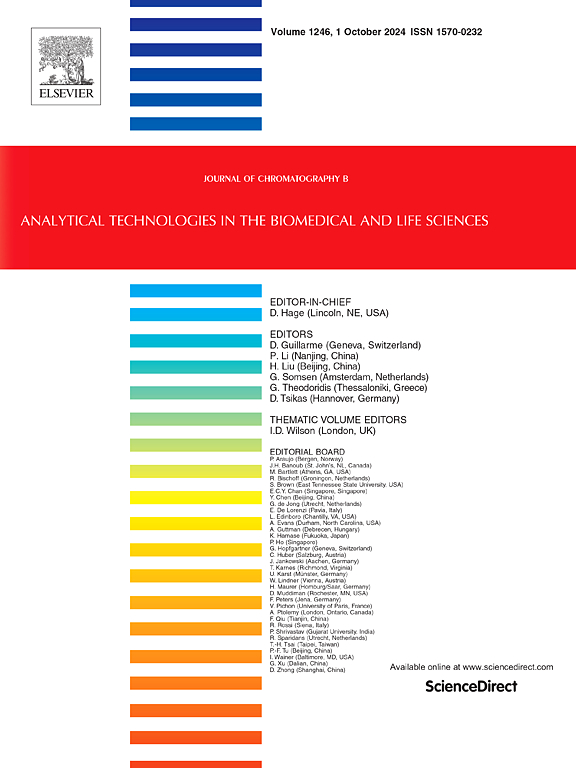多功能完整LC-MS方法评价人血浆中抗体-药物偶联物的药物-抗体比率和药物负荷分布
IF 2.8
3区 医学
Q2 BIOCHEMICAL RESEARCH METHODS
引用次数: 0
摘要
给药后,抗体-药物偶联物(ADC)的平均药物-抗体比(DAR)和药物负荷分布(DLD)可以通过生物转化而改变。此外,药物负荷影响ADC的清除和暴露。评估ADC体内平均DAR和DLD的变化将为更好地了解ADC的药代动力学(PK)特征提供有价值的信息。虽然使用LC-MS定量抗体/ adc通常与亲和捕获方法相结合,但在这里,我们的目标是开发一种通用的完整LC-MS方法来评估人血浆中adc的平均DAR和DLD。在健康的人血浆中加入模型adc、市售曲妥珠单抗emtansine (T-DM1)和brentuximab vedotin (B-MMAE),并利用重组蛋白HER2和CD30分别捕获T-DM1和B-MMAE,建立亲和纯化工艺和方法验证。作为本研究的独特之处,首先,我们建立了一个两步梯度,用于少量ADC的灵敏检测。考虑到其在LC-MS分析中的应用,优化了亲和捕获后的ADC洗脱条件。此外,首次提出了完整LC-MS方法分析人血浆样品中adc的平均DAR和DLD的验证研究。通过验证研究,验证了我们的分析方法的性能特征,包括灵敏度、中间精密度、准确度、结转和自进样器稳定性。此外,通过与6个实验室的合作研究,验证了该方法的可行性。最后,我们的方法被证明可用于评估人血浆中adc的平均DAR和DLD。本文章由计算机程序翻译,如有差异,请以英文原文为准。
Versatile intact LC–MS method for evaluating the drug–antibody ratio and drug load distribution of antibody–drug conjugates in human plasma
The average drug–antibody ratio (DAR) and drug load distribution (DLD) of an antibody–drug conjugate (ADC) can be altered by biotransformation after administration. In addition, drug loading affects the clearance and exposure of the ADC. Evaluating alterations in the average DAR and DLD of an ADC in vivo would provide valuable information to better understand of the pharmacokinetic (PK) profile of the ADC. Although the quantitation of antibodies/ADCs using LC–MS is often coupled with affinity capture methods, here, we aimed to develop a versatile intact LC–MS method for evaluating the average DAR and DLD of ADCs in human plasma. The development of the affinity purification process and method validation were performed using healthy human pooled plasma spiked with the model ADCs, commercially available trastuzumab emtansine (T-DM1) and brentuximab vedotin (B-MMAE), and the recombinant proteins HER2 and CD30 were used to capture T-DM1 and B-MMAE, respectively. As unique points of this study, initially, a two-step gradient was established for the sensitive detection of a small amount of ADC. The ADC elution conditions after affinity capture were also optimized considering its application for LC–MS analysis. Furthermore, a validation study of the intact LC–MS approach for analyzing the average DAR and DLD of ADCs in human plasma sample was proposed for the first time. Using the validation study, our analytical method was validated by verifying its performance characteristics, including sensitivity, intermediate precision, accuracy, carryover and autosampler stability. In addition, the feasibility of applying our method was demonstrated by a collaborative study with six laboratories. Finally, our method was shown to be versatile for evaluating the average DAR and DLD of ADCs in human plasma.
求助全文
通过发布文献求助,成功后即可免费获取论文全文。
去求助
来源期刊

Journal of Chromatography B
医学-分析化学
CiteScore
5.60
自引率
3.30%
发文量
306
审稿时长
44 days
期刊介绍:
The Journal of Chromatography B publishes papers on developments in separation science relevant to biology and biomedical research including both fundamental advances and applications. Analytical techniques which may be considered include the various facets of chromatography, electrophoresis and related methods, affinity and immunoaffinity-based methodologies, hyphenated and other multi-dimensional techniques, and microanalytical approaches. The journal also considers articles reporting developments in sample preparation, detection techniques including mass spectrometry, and data handling and analysis.
Developments related to preparative separations for the isolation and purification of components of biological systems may be published, including chromatographic and electrophoretic methods, affinity separations, field flow fractionation and other preparative approaches.
Applications to the analysis of biological systems and samples will be considered when the analytical science contains a significant element of novelty, e.g. a new approach to the separation of a compound, novel combination of analytical techniques, or significantly improved analytical performance.
 求助内容:
求助内容: 应助结果提醒方式:
应助结果提醒方式:


